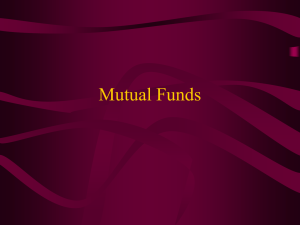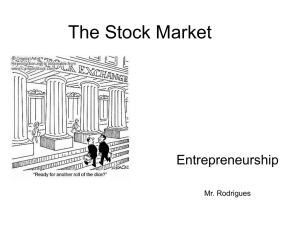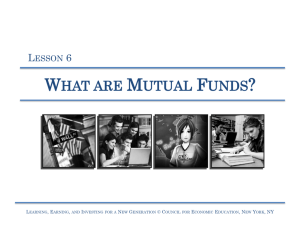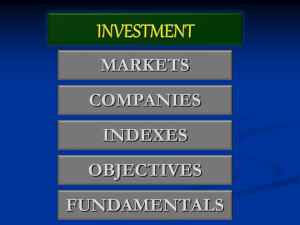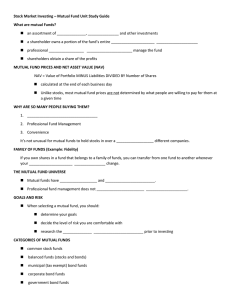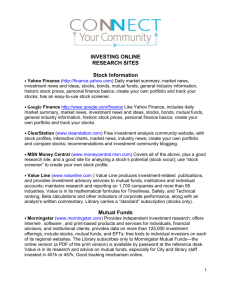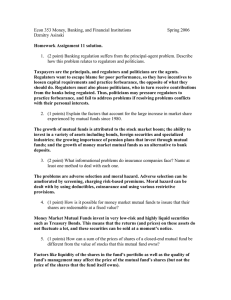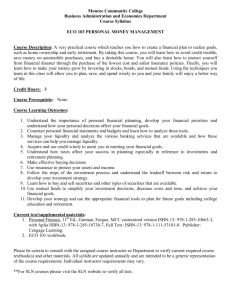Indexes Mutual Funds - Andress High School
advertisement
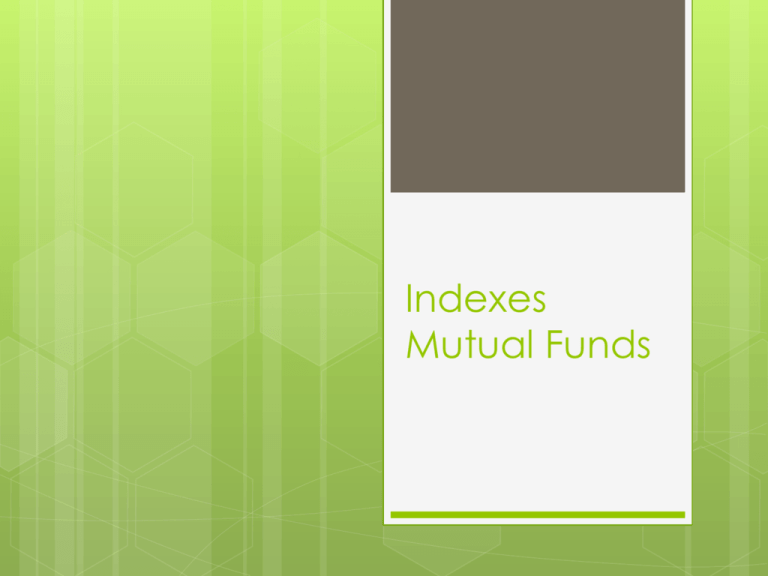
Indexes Mutual Funds Stock Market Index A method of measuring the value of a section of the stock market Computed from the prices of selected stocks Describes the market and compares the return on specific investments S & P 500 Index Standard & Poor’s 500 Standard and Poor are the last names of the two men that founded the index Companies included in the index are selected by the S & P Index Committee Companies included in the index trade common stock on the NYSE S & P 500 Index Top 500 companies Chosen for their market size, liquidity and industry grouping Liquidity-The degree to which a stock can be sold without affecting the price Characterized by high level of trading activity Assets that can be easily bought or sold are considered liquid assets S & P 500 Index, In a Nutshell Essentially, the S & P 500 is a report From this report, you can see how the top 500 companies are doing on the stock market and what their market value is This helps you decide if the stock you are considering purchasing is a good investment Just because the company is not on the list does not mean their stock is not a good investment Examples Some companies currently listed on the S & P 500: Abercrombie & Fitch (ANF) Pepsi Co. (PEP) Mastercard, Inc. (MA) Wells Fargo (WFC) Google (GOOG) Dow Jones Industrial Average an index that shows how 30 large publicly owned companies based in the United States have traded during a standard trading session in the stock market Founded by Charles Dow and Edward Jones Lists stocks traded on both the NYSE and NASDAQ Dow Jones Industrial Average Often referred to as “The Dow” Basically a market report, just like the S & P 500 Portfolio A grouping of financial assets such as stocks, bonds & mutual funds If you have investments, they are grouped in your portfolio Bonds A debt investment in which an investor loans money to an entity (corporate or governmental) that borrows the funds for a defined period of time at a fixed interest rate. Bonds are used by companies, municipalities, states and U.S. and foreign governments to finance a variety of projects and activities. Mutual Funds A type of investment made up money from many investors for the purpose of investing in a variety of different types of securities at once There are more than 17,000 mutual funds to choose from Open-Ended Funds Sell as many shares as investors want to buy They will only stop selling shares if the fund grows too large If you want to sell your shares, you sell them back to the fund Closed-End funds Only a fixed number of shares are sold on the stock exchange Once all the shares are sold, no others can be bought Exchange-Traded funds This type of fund invests in stocks that closely follow an index Making Money on Mutual Funds Just like stocks, Mutual Funds grow in value and are paid dividends The managers of the fund sell the securities at a profit and distribute the money to fund holders Variety You can invest in many types of mutual funds Some funds have a purpose A number of funds have been created to support ideas or causes Special Mutual Funds Some funds support particular causes such as: Women’s Issues Companies with socially responsible business practices Family friendly companies Mutual Fund Families A group of funds offered by the same investment company A fund family can use different distributors for different funds The family of funds will often include many different types of securities Diversification A risk management technique that mixes a wide variety of investments within a portfolio Mutual funds are a great investment because they offer diversification The goal of diversification is to try to balance underperforming stocks with stocks that are doing well Ticker Symbols Five letters long End in an “X” Morningstar An investment research firm that compiles mutual, stock and general market data Respected and reliable source of investment analysis Risk Rating Morningstar rates mutual funds according to their level of risk Rankings are from 1-5 1 is the poorest and 5 is the best Ratings are designed to quickly identify funds to consider purchasing YTD Return Year to date (YTD) The period beginning January 1of the current year up until today’s date The percentage of profit an ivestment is making so far this year NAV Net Asset Value The price at which investors buy and sell from a fund company
